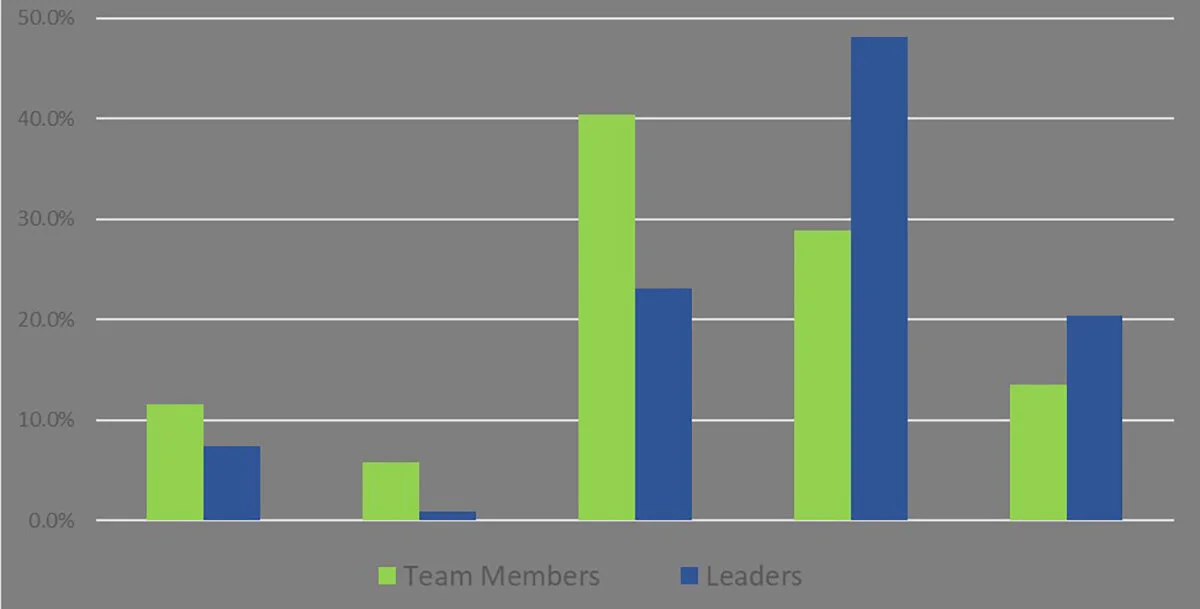Leader and Team Member Emotional Responses – Compassionate Leadership Amid the Chaos Survey Results
In our recent survey, “Compassionate Leadership Amid the Chaos,” we asked survey participants to respond to the question, “What range of emotions have you been feeling over the last two weeks? Choose up to three.” In this post, we would like to discuss the results of the responses we received from leaders and from team members who were not leaders. (For context, the survey was fielded from March 27 – April 10.)
The most frequently cited emotion among both leaders and team members was, not surprisingly, anxiety. Forty-four percent of leaders expressed that they were experiencing anxiety while 37% of team members were feeling anxious as well. Other than the shared experience of anxiety, the survey responses of leaders and team members diverged. We have an opportunity to learn from these divergences, and highlight three emotions: resilience, powerlessness, and acceptance.
Resilience
The largest gap in experienced emotions was in resilience, with 35% of leaders saying they were feeling resilient, while only 15% of team members felt the same. Resilience is precisely the attribute organizations will be needing from their team members as we emerge from the current crisis. Resilience is the ability to adapt to and learn from adversity, or can be described as the ability to “bounce back” following a challenging period or event.
The good news is that resilience can be learned and supported in the workplace, before, during, and after adverse experiences. What can leaders do to develop resilience among their teams today?
First, make sure your team has a strong sense of a shared mission and values. Combating adversity is much easier done together than alone.
Shared mission and values must be supported by trusting and supportive relationships, which make communication, transparency, and psychological safety critical elements for building resilience. Communicating short- and medium-term goals for your team reinforces their confidence in their ability to bounce back.
Finally, creating a positive mindset points your team in the right direction. It is important that your team understand that while they can’t choose the external factors impacting their work, they can choose how they respond to the outside factors.
Powerlessness and Acceptance
Team members expressed a much higher rate of feeling powerless and acceptance than leaders. Of team members surveyed, 35% said they were feeling acceptance and 28% said they were feeling powerlessness. These were the second and third most common emotions for team members after anxiety. Leaders, on the other hand, were feeling acceptance and powerlessness at a rate of 18% and 17%, respectively, and these emotions ranked in the middle of the list of the emotions they were experiencing.
Team members look to their leader for guidance and permission about how and where to exert their own power. Recognize that the steps to empower your team overlap with the steps taken to build resilience. Empower teams with shared purpose, information, safety, and goals. Communications, transparency, and a positive mindset are each valuable to help counter powerlessness and acceptance.
Remember too, that as a leader the emotions, behavior and beliefs you model for the team can have the most profound impact on their emotional response.
Other Emotions
Our survey results show a difference in the experience of compassion among leaders (43%) and team members (28%). We will devote a future article exclusively to the findings of our survey around compassion.
There was also large gap in the percent of leaders and team members who said that they were experiencing anger. While anger was not a top five named emotion of team members, 20% of team members said that they were experiencing anger, as opposed to only 7% of leaders. In our next post focused on our research results, we will look at the actions leaders say they are taking and compare that to the responses of team members.
Are there other aspects of these answers that you find particularly interesting? Leave a comment below or send us an email at hqcfcl@gmail.com. We are interested to hear about your reactions to this information or any other comments you have.
Methodology
The Center for Compassionate Leadership conducted a short survey from March 27 – April 10 as a global community project to help us all appreciate the impact of the COVID-19 pandemic on leadership and compassion. We received over 200 responses from twenty-two countries on all six continents. (We didn’t receive any responses from Antarctica.) Nearly three-fourths of the responses came from the United States, with the United Kingdom and Canada representing another eight and six percent, respectively. We received multiple responses from Rwanda, France, Singapore, and Uganda, while the remaining fifteen countries had one response each.
Sixty-five percent of respondents identified as female, thirty-four percent as male, and one percent as non-binary. In order to best understand the role of compassion in leadership, we asked respondents to categorize themselves as a “leader, founder, or manager,” as an “employee or team member,” or as “self-employed or solo entrepreneur.” In our posts about the survey, we refer to those three groups as “leaders,” “team members,” or “self-employed.” For reference, 50% of respondents identified as leaders, 23 % identified as team members, and 28 % identified as self-employed.


